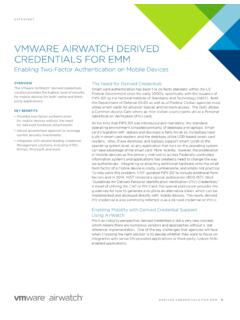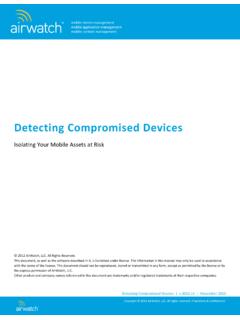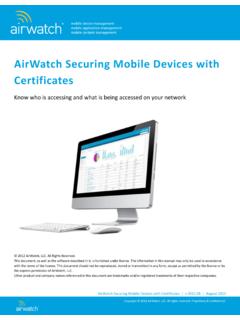Transcription of AirWatch Support for Office 365 - VMware
1 AirWatch Support forAirWatch Support for Of ce 365 AirWatch Support for Office 365 One of the most common questions being asked by many customers recently is How does AirWatch Support Office 365? Many ask if AirWatch can control access to Office 365 (O365) not only on their corporate desktop systems, but most importantly on their mobile , AirWatch by VMware provides tremendous Support to help organizations leverage O365 on their mobile devices and our recent integration with VMware Identity Manager provides an industry-first adaptive access control framework to ensure that all work applications, including O365, can only be accessed on managed and compliant Office 365 ChallengeMigrating to O365 for an organization presents a host of new challenges.
2 First, given that O365 is accessible from the Internet, traditional access control mechanisms for email and apps, which are based on network and perimeter security models, fail to work. Secondly, unlike their desktop equivalents, mobile Office apps present new, complex challenges for BYOD users including containerization and remote organizations need is a way to restrict O365 access to only managed and compliant devices without any dependency on the network or domain membership. Additionally, they need to ensure that any data stored on a device is encrypted and can be remotely wiped if lost or stolen. While this may seem trivial at first, it gets increasingly complex considering the many platforms and the complexity in enabling the ability for the solution to co-exist with both enterprise mobility management (EMM) and domain managed devices.
3 Complexity is also added when integrating EMM and domain managed devices with existing on-premise infrastructure. While this white paper specifically discusses how AirWatch solves these problems for O365, the same architecture secures all company applications both cloud and O365 Integration AirWatch enables users to easily use O365 by providing a common identity for authentication, providing conditional access control to ensure only managed devices gain access and containerize the data on the device to ensure it s secure and can be remotely wiped. Not only is this great news for IT and security, but AirWatch also enables self-service provisioning of O365 access by end users to make the entire process simple and automated; allowing easy scaling of O365 across the entire and Secure SSO AccessTo make an effortless user experience, integration of AirWatch with VMware Identity Manager allows organizations to easily federate their existing on-premise corporate identity ( LDAP or Active Directory) and automatically single-sign-on (SSO) into O365 apps.
4 This allows users to navigate to a single webpage portal, login with their company credentials and easily get access to email, Lync, and all other Office apps without having to re-enter credentials for every single Support for Of ce 365In addition to web based apps, AirWatch Catalog and EMM capabilities allow users to securely download native O365 applications and set up email on their mobile of the most unique advantages AirWatch and VMware Identity Manager provide is to configure the same SSO experience a user expects from web applications using the native mobile apps. AirWatch can also leverage digital certificates to automatically sign the user into O365; providing passwordless authentication. Not only is the user experience superior but security is increased by using certificates to authenticate rather than AD passwords.
5 Since AirWatch installs the certificate in a single secure location, all applications on the device can leverage this identity for authentication. This increases security from two perspectives. First, since AirWatch stores the user s identity in a single location in the OS, company credentials are not stored or accessible by the applications on the device. This means IT does not have to worry about how each application might be storing a user s credentials and minimizes the risk of a single application getting exploited. Secondly, since a digital certificate is used rather than a username and password, security is greatly increased. If a device is stolen, the certificate can easily be revoked and access to that specific mobile device can be fully denied without forcing the user to change their password across all company systems and also makes the process of provisioning access to different O365 applications easy and automated by syncing with existing Active Directory (LDAP) user groups.
6 This ensures only authorized users with purchased licenses are able to access O365 services and automatically revokes access to unauthorized users without requiring any IT involvement or calls to the help desk. Today, the activation and deprovisioning process are two decoupled processes of revoking access from the identity management system and remotely wiping data and applications from the endpoint device. AirWatch brings these two workflows together to automate and streamline the Access to Authorized Users and DevicesIn general, only authorized users on authorized devices should be granted access to company applications. For O365 this means services such as Exchange Online, OneDrive, Lync, etc. should be restricted to only compliant and managed devices.
7 AirWatch integrates with both O365 APIs and VMware Identity Manager to provide conditional access to all O365 services. Exchange OnlineAirWatch integrates directly with Exchange Online to restrict email. This is done by first setting up a whitelist policy in Exchange to deny email access as a default behavior for all unknown devices. AirWatch then integrates with Exchange Online to automatically add managed and compliant devices to a whitelist so they are authorized to sync email. If a user activates a new device or an existing device goes out of compliance, AirWatch automatically syncs the changes with Exchange Online. AirWatch integration works directly with O365 so devices can connect from any network without forcing email traffic through a VPN or on-premise Support for Of ce 365O365 AppsIn addition to email, AirWatch integration provides the same conditional access to all other O365 applications.
8 When a user attemps to access O365 and authenticate, O365 redirects the authentication to VMware Identity Manager as part of the federated configuration. The authentication not only validates the user identity but also validates that the device is managed and compliant by AirWatch . If a user tries to connect to O365 from an unmanaged mobile device, access is of the differentiating advantages with this architecture is the flexibility to require different claims rules for authentication based on the device platform and app requesting access. This allows organizations to have different policies for mobile devices than from existing domain joined company computers. For example: Apple iOS native applications can require authentication using certificates Android native applications can require authentication using certificates Windows native applications can require domain membership and authentication Web-browser based sessions can have limited access or be required to be on the company VPN or network to access O365 VMware Identity ManagerValidates User IdentityVMwareIdentity Manager+ AirWatch Support for Of ce 365 Integration with Other Third Party Identity Access Management ToolsWhile AirWatch provides seamless integration with VMware Identity Manager and is included in the AirWatch Blue and Yellow Management Suites.
9 AirWatch can also integrate with existing identity solutions that organizations might already be using. This ensures that current configurations and federated authentication policies can continue to exist while still providing a better SSO and conditional access framework for mobile and managed diagram below outlines how the same configuration can co-exist with an organization s existing third party identity tool (Ping, Okta, ADFS, Azure AD, etc.).VMwareIdentity ManagerExistingIdentity ProviderADFS ADActiveDirectoryAirWatch Support for Of ce 365 Containerize and Protect DataIn addition to having a common identity, SSO experience and conditional access to only managed devices, companies must also ensure O365 data is protected on the device itself.
10 This includes ensuring the device is encrypted, policies are set to prevent data leakage and ensuring that O365 data can be remotely wiped from the device if lost or deploying O365 apps through AirWatch Catalog, AirWatch enforces containerization of these applications to prevent data loss using the native platform controls. Each OS supports different containerization controls as outlined below: Apple iOS: AirWatch integrates with Apple s managed app containerization technology to prevent data lossfrom work and personal applications. This includes preventing Exchange Online emails from being movedfrom the work account to personal and managing the open-in controls to prevent email attachmentsfrom being saved into personal applications.


